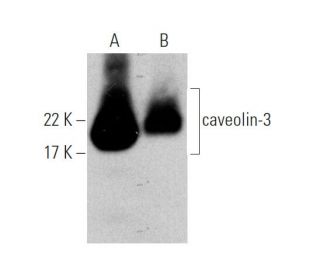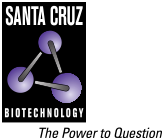
Click on image or enlarge button to enlarge
caveolin-3 Antibody (A-3): sc-5310
- caveolin-3 Antibody (A-3) is a mouse monoclonal IgG1 κ caveolin-3 antibody, cited in 63 publications, provided at 200 µg/ml
- specific for an epitope mapping between amino acids 3-40 at the N-terminus of caveolin-3 of mouse origin
- caveolin-3 Antibody (A-3) is recommended for detection of caveolin-3 of mouse, rat and human origin by WB, IP, IF, IHC(P) and ELISA
- Anti-caveolin-3 Antibody (A-3) is available conjugated to agarose for IP; HRP for WB, IHC(P) and ELISA; and to either phycoerythrin or FITC for IF, IHC(P) and FCM
- also available conjugated to Alexa Fluor® 488, Alexa Fluor® 546, Alexa Fluor® 594 or Alexa Fluor® 647 for WB (RGB), IF, IHC(P) and FCM, and for use with RGB fluorescent imaging systems, such as iBright™ FL1000, FluorChem™, Typhoon, Azure and other comparable systems
- also available conjugated to Alexa Fluor® 680 or Alexa Fluor® 790 for WB (NIR), IF and FCM; for use with Near-Infrared (NIR) detection systems, such as LI-COR®Odyssey®, iBright™ FL1000, FluorChem™, Typhoon, Azure and other comparable systems
- Contact our Technical Service Department (or your local Distributor) for more information on how to receive a FREE 10 µg sample of caveolin-3 (A-3): sc-5310.
- m-IgG Fc BP-HRP and m-IgG1 BP-HRP are the preferred secondary detection reagents for caveolin-3 Antibody (A-3) for WB and IHC(P) applications. These reagents are now offered in bundles with caveolin-3 Antibody (A-3) (see ordering information below).
QUICK LINKS
caveolin-3 Antibody (A-3) is an IgG1 κ mouse monoclonal caveolin-3 antibody (also designated CAV3 antibody) that detects the caveolin-3 protein of mouse, rat and human origin by WB, IP, IF, IHC(P) and ELISA. caveolin-3 Antibody (A-3) is available as both the non-conjugated anti-caveolin-3 antibody form, as well as multiple conjugated forms of anti-caveolin-3 antibody, including agarose, HRP, PE, FITC and multiple Alexa Fluor® conjugates. Caveolae (also known as plasmalemmal vesicles) are 50-100 nM flask-shaped membranes that represent a subcompartment of the plasma membrane. On the basis of morphological studies, caveolae have been implicated to function in the transcytosis of various macromolecules (including LDL) across capillary endothelial cells, uptake of small molecules via potocytosis and the compartmentalization of certain signaling molecules including G protein-coupled receptors. Three proteins, caveolin-1, caveolin-2 and caveolin-3, have been identified as principal components of caveolae (6-8). Two forms of caveolin-1, designated alpha and beta, share a distinct but overlapping cellular distribution and differ by an amino terminal 31 amino acid sequence which is absent from the beta isoform. Caveolin-1 shares 31% identity with caveolin-2 and 65% identity with caveolin-3 at the amino acid level. Functionally, the three proteins differ in their interactions with heterotrimeric G protein isoforms (6-8).
Alexa Fluor® is a trademark of Molecular Probes Inc., OR., USA
LI-COR® and Odyssey® are registered trademarks of LI-COR Biosciences
References:
- Caveolin, a protein component of caveolae membrane coats. | Rothberg, KG., et al. 1992. Cell. 68: 673-82. PMID: 1739974
- Morphological changes of the 3T3-L1 fibroblast plasma membrane upon differentiation to the adipocyte form. | Fan, JY., et al. 1983. J Cell Sci. 61: 219-30. PMID: 6885939
- Characterization of caveolin-rich membrane domains isolated from an endothelial-rich source: implications for human disease. | Lisanti, MP., et al. 1994. J Cell Biol. 126: 111-26. PMID: 7517942
- VIP21/caveolin, glycosphingolipid clusters and the sorting of glycosylphosphatidylinositol-anchored proteins in epithelial cells. | Zurzolo, C., et al. 1994. EMBO J. 13: 42-53. PMID: 8306971
- Identification, sequence, and expression of caveolin-2 defines a caveolin gene family. | Scherer, PE., et al. 1996. Proc Natl Acad Sci U S A. 93: 131-5. PMID: 8552590
- Molecular cloning of caveolin-3, a novel member of the caveolin gene family expressed predominantly in muscle. | Tang, Z., et al. 1996. J Biol Chem. 271: 2255-61. PMID: 8567687
- Phosphorylation of caveolin by src tyrosine kinases. The alpha-isoform of caveolin is selectively phosphorylated by v-Src in vivo. | Li, S., et al. 1996. J Biol Chem. 271: 3863-8. PMID: 8632005
- Expression of caveolin-3 in skeletal, cardiac, and smooth muscle cells. Caveolin-3 is a component of the sarcolemma and co-fractionates with dystrophin and dystrophin-associated glycoproteins. | Song, KS., et al. 1996. J Biol Chem. 271: 15160-5. PMID: 8663016
Ordering Information
| Product Name | Catalog # | UNIT | Price | Qty | FAVORITES | |
caveolin-3 Antibody (A-3) | sc-5310 | 200 µg/ml | $310.00 | |||
caveolin-3 Antibody (A-3): m-IgG Fc BP-HRP Bundle | sc-526483 | 200 µg Ab; 10 µg BP | $348.00 | |||
caveolin-3 Antibody (A-3): m-IgG1 BP-HRP Bundle | sc-531856 | 200 µg Ab; 20 µg BP | $348.00 | |||
caveolin-3 Antibody (A-3) AC | sc-5310 AC | 500 µg/ml, 25% agarose | $408.00 | |||
caveolin-3 Antibody (A-3) HRP | sc-5310 HRP | 200 µg/ml | $310.00 | |||
caveolin-3 Antibody (A-3) FITC | sc-5310 FITC | 200 µg/ml | $324.00 | |||
caveolin-3 Antibody (A-3) PE | sc-5310 PE | 200 µg/ml | $337.00 | |||
caveolin-3 Antibody (A-3) Alexa Fluor® 488 | sc-5310 AF488 | 200 µg/ml | $350.00 | |||
caveolin-3 Antibody (A-3) Alexa Fluor® 546 | sc-5310 AF546 | 200 µg/ml | $350.00 | |||
caveolin-3 Antibody (A-3) Alexa Fluor® 594 | sc-5310 AF594 | 200 µg/ml | $350.00 | |||
caveolin-3 Antibody (A-3) Alexa Fluor® 647 | sc-5310 AF647 | 200 µg/ml | $350.00 | |||
caveolin-3 Antibody (A-3) Alexa Fluor® 680 | sc-5310 AF680 | 200 µg/ml | $350.00 | |||
caveolin-3 Antibody (A-3) Alexa Fluor® 790 | sc-5310 AF790 | 200 µg/ml | $350.00 | |||
caveolin-3 (A-3) Neutralizing Peptide | sc-5310 P | 100 µg/0.5 ml | $67.00 |
